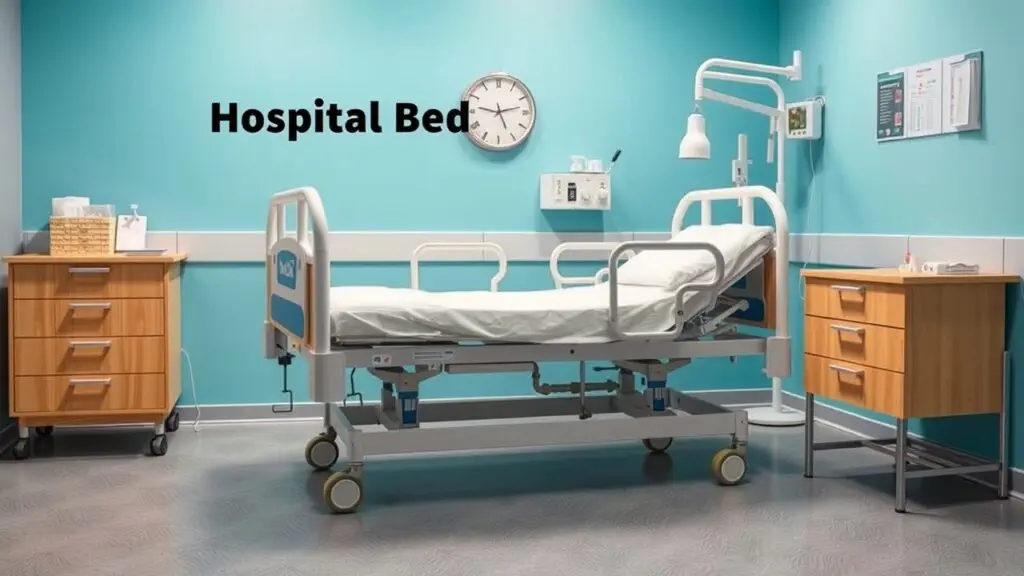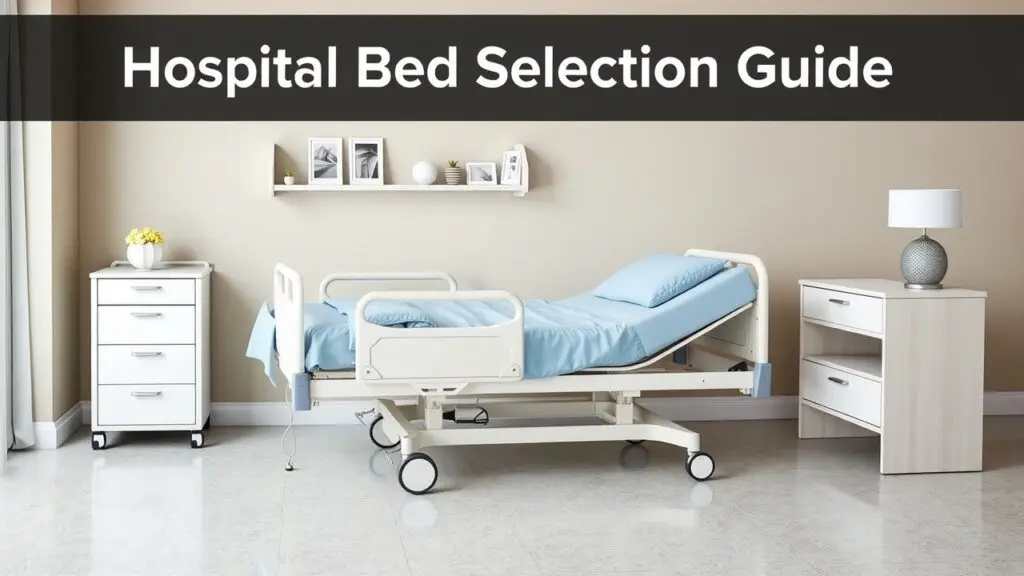Explore various types of hospital beds, including electric, manual, bariatric, and pediatric, each designed for specific patient needs and medical conditions. Choosing the right bed depends on factors like patient mobility, size, and medical requirements.
What Are Hospital Beds?

Hospital beds are special types of medical equipment. They are designed to help patients feel comfortable during their recovery. Unlike regular beds, these beds can change height and position. This allows healthcare professionals to provide better care. Many adjustable hospital beds have features like side rails and wheels for easy movement. They also offer different mattress options to meet various needs. The main goal is to improve patient comfort while making it easier for caregivers to help.
Why Understanding Different Types of Hospital Beds Matters?
Knowing the different types of hospital beds is important for several reasons:
- For Healthcare Providers: Understanding bed types helps match features with patients’ needs for better care.
- For Caregivers and Families: It aids in choosing the right bed for home or facility use, ensuring that patients get the support they need.
- For Buyers: Learning about different models helps make informed purchasing decisions by considering important factors like costs and features.
By knowing these differences, everyone can make better choices that lead to improved health outcomes.
Overview of Key Types of Hospital Beds
Several key types of hospital beds meet different patient needs:
- General Purpose Hospital Beds: These beds are versatile and can serve many patients needing basic medical care. They may have manual adjustments or electric options.
- Bariatric Hospital Beds: Designed for larger individuals, these beds provide extra width and weight capacity while keeping safety and comfort in mind.
- ICU (Intensive Care Unit) Hospital Beds: These beds come with advanced technology that allows precise positioning, essential for critically ill patients who need constant monitoring.
- Pediatric-Specific Designs: These smaller beds cater specifically to children’s needs, often featuring fun designs to ease anxiety during treatment.
- Geriatric Hospital Beds: Focused on elderly patients, these beds enhance safety with lower heights and added support features like grab bars or pressure-relieving mattresses.
Each type plays an important role in healthcare settings or home environments, ensuring that every patient’s specific needs are effectively met.
Comprehensive Guide to Types of Hospital Beds
General Purpose Hospital Beds Explained
General purpose hospital beds are used for many patients with different medical needs. They usually have adjustable features that make patients more comfy and help caregivers do their jobs. The main types of these beds are:
- Manual Hospital Beds: Caregivers adjust these beds by turning hand cranks. They’re cheaper but can be tricky for frequent changes.
- Semi-Electric Hospital Beds: These beds let caregivers adjust the head and foot sections electrically, but they still need a hand crank for height adjustments. This mix makes them easy to use without being too costly.
- Fully Electric Hospital Beds: These have electric motors for all adjustments, giving the most comfort to patients and ease for caregivers. A simple button press changes the bed position.
Comfort in hospital beds is super important. It can help patients heal faster. Features like pressure-relieving mattresses can stop bedsores. Plus, side rails keep patients safe when they move around.
Bariatric Hospital Beds Overview
Bariatric hospital beds are made just for obese patients who need extra support due to their weight. These beds can hold more weight—usually over 500 pounds—and have strong frames.
Key features include:
- Weight Capacity: Bariatric beds are built tough to safely support heavier people.
- Pressure-Relieving Mattresses: Many of these beds come with special mattresses that spread weight evenly. This helps avoid pressure points and sores.
- Fall Prevention Features: Safety is key! Many bariatric beds sit lower to the ground or have wider side rails to help stop falls.
These features make bariatric hospital beds essential for caring safely and comfortably for larger patients.
ICU/Critical Care Unit Beds Explained
ICU or critical care unit beds are designed for very sick patients who need constant care. These advanced beds use cool tech that helps healthcare workers provide great care.
Important features include:
- Monitoring Capabilities: Many ICU beds have systems built in that check vital signs like heart rate and oxygen levels right from the bed.
- Life-Support Integration: Some models connect easily to life-support machines. This means quick help in emergencies is possible.
These beds also focus on making it easy for healthcare providers to reach patients while keeping them comfortable during treatment.
Pediatric-Specific Designs in Hospital Beds
Pediatric hospital beds are made just for kids’ needs in hospitals. They focus on safety while being friendly and fun for young patients.
Common features of pediatric beds include:
- Lower heights so young kids can get in and out easily,
- Bright colors or fun themes that kids enjoy,
- Side rails designed for safety while allowing parents easy access,
These elements create a comforting space that helps kids heal better, meeting both practical needs and keeping children calm during their stay in the hospital.
Geriatric and Specialty Hospital Beds
Geriatric Hospital Beds: Features and Considerations
Geriatric hospital beds are made for older patients. They have special features to keep seniors safe and comfortable.
Key Features
These beds have easy-to-use controls. This helps older adults change their position without help. They also come with safety features that prevent falls, which is super important for those who might struggle with balance. Plus, the materials used are strong and easy to clean. This means they last a long time and stay hygienic.
Use Cases
Geriatric hospital beds fit well in wards where special care is needed. They’re also great in rehab centers to support recovery. These beds help caregivers ensure patients are comfy and safe.
Some brands focus on making beds that meet the needs of elderly patients. They prioritize functionality and ease of use.
Specialty Hospital Beds: Addressing Specific Needs
Specialty hospital beds are designed for specific medical needs that regular beds can’t handle.
Types of Specialty Beds:
- Surgical Beds: These have adjustable features and can work with life-support machines, making them ideal for operating rooms.
- Recovery Beds: These beds focus on helping patients heal after surgery by keeping them in the right position.
- Orthopedic & Neurological Beds: Made for those recovering from surgeries or dealing with ongoing health issues, these beds provide extra support.
Considerations When Choosing a Specialty Bed
When picking a specialty bed, think about what the patient needs based on their condition, like if they have a spinal injury. It’s also key to check if the bed works with other medical tools, like electronic monitors.
Pediatric-Specific Designs in Hospital Beds
Pediatric hospital beds are built for kids. They include features that make them safe and easy for caregivers to use.
Child-safe Mechanisms
These beds come with rails to prevent little ones from falling out, which is important for infants and toddlers.
Features Unique to Pediatric Units
They often have adjustable heights so caregivers can easily reach kids while keeping them safe. All these design choices make healthcare more pleasant for young patients.
Choosing the Right Hospital Bed: A Decision Guide
Factors to Consider When Selecting a Hospital Bed
Picking the right hospital bed is super important for keeping patients comfy and safe. Here are some things you should think about:
- Patient Needs: First, check what the patient really needs. Is the patient old or young? What’s their weight? If they’re heavier, you’ll need to think about special beds. Also, look for any health problems that need features like helping to stop bed sores.
- Adjustability: Adjustable hospital beds are great because they let patients change positions easily. Make sure the bed can move up and down in different ways, like lifting the head or feet.
- Weight Capacity: Different beds hold different weights. Make sure to choose one that can hold the patient’s weight without wobbling or being unsafe.
- Fall Prevention Features: Beds with side rails or ones that sit low to the ground help keep patients from falling out of bed. This is really important for older people or those who have trouble moving.
- Home Healthcare Equipment Compatibility: If you’re using this bed at home, make sure it fits in the space without crowding things like oxygen tanks or IV stands.
- Medical Technology Integration: Some newer beds have cool features like monitoring tools for ICU patients. These can give real-time info about vital signs and other important data.
Patient Needs Assessment
Understanding what a patient needs is key:
- Age matters when choosing features; older adults usually need more support.
- Weight is a big deal too, especially for bariatric beds made for heavier folks.
- Health issues are also important; some illnesses might require special mattresses that help prevent sores.
Look for mobility aids too, like grab bars or adjustable heights to help get in and out of bed easily.
Available Space and Accessibility
When choosing a hospital bed, check how much space you have:
- Measure your room well so there’s enough space not just for the bed but also for caregivers to move around.
- In nursing homes or rehab centers, layout matters too! Make sure it’s easy to get around without bumping into stuff while following health rules.
Budget Constraints
Money plays a big role when deciding whether to buy or rent a hospital bed:
- Know the costs of different types—some are cheap and good for home use while others are pricier for hospitals.
- Renting might be smart if you don’t want a long-term commitment; many places offer flexible options based on how long you need it.
Check if insurance can cover some of these costs! It’s smart to read through policies before you decide.
Consult with Healthcare Professionals
Talking with healthcare experts before buying helps a lot! They can give tips on which type of bed is best for certain patient needs based on their health issues and care plan—whether at home with geriatric care or in an ICU setting.
Hospital Bed Materials
Materials Used in Hospital Bed Construction
Hospital beds are made with strong materials that keep patients safe and comfy. The frames are usually built from metals like steel or aluminum. This gives the beds strength while making them easy to move around.
The mattress choice matters too. Different mattresses fit different patient needs. For example, pressure-relieving mattresses help prevent bedsores for patients who can’t move much. Ergonomic designs help support the body’s natural shape for better rest.
Impact on Durability and Comfort
When picking hospital equipment, durability is key because it affects costs and care quality over time. Sturdy materials mean the beds last longer and meet hygiene standards that are really important in hospitals. Beds with surfaces that are easy to clean help stop infections.
Comfort is also super important for recovery. Beds that can be adjusted to different positions make a big difference in how patients feel during their stay.
Types of Mattresses for Hospital Beds
There are several mattress types:
- Foam Mattresses: These give basic support and comfort. They work well for many patients who don’t need special care.
- Air-Filled Mattresses: These are great for at-risk patients as they provide relief from pressure by moving air around, helping to avoid pressure ulcers.
- Gel Mattresses: These help with keeping cool and offer cushioning. They spread out weight evenly on the surface.
Each mattress type helps improve patient care by meeting individual needs.
Technology Integration in Modern Hospital Beds
Electronic Monitoring Systems
Today’s hospital beds often come with electronic monitoring systems. This tech lets nurses check vital signs right from the bed without needing extra machines. It helps life-support functions work smoothly in hospitals.
EHR System Compatibility
Modern beds also connect well with Electronic Health Record (EHR) systems. This connection makes it easier to manage patient data since updates can happen right from the bedside.
Advanced Features in Smart Beds
Smart beds have features that make things better for both staff and patients:
- Remote control functions let caregivers adjust bed positions easily, which keeps patients undisturbed.
- Automated height adjustments make it safer and easier for staff to help patients get in and out of bed, reducing fall risks.
These advances show how technology is changing healthcare for better patient outcomes.
Hospital Bed Maintenance and Safety
Proper Cleaning and Disinfection of Hospital Beds
Keeping hospital beds clean is super important for patient safety. If you don’t clean them, germs can spread, and that’s not good. You should follow the proper cleaning procedures and disinfection protocols. This helps meet healthcare hygiene standards. The CDC has some great guidelines on this.
To clean a hospital bed properly, staff should:
- Take off all the linens from the bed.
- Wear the right personal protective equipment (PPE).
- Clean surfaces with soap or detergent first.
- Use disinfectants as directed and let them sit for the right time.
Checking the bed regularly is also part of maintenance. Make sure to look for wear and tear, see if all moving parts work well, and replace any broken parts right away.
Safe Operation and Maintenance of Hospital Beds
Using hospital beds safely is key to avoiding accidents. Staff need to know how to operate different types of beds properly, whether they are manual or electric.
Creating regular maintenance schedules helps find problems early. Common issues include:
- Checking power sources for electric beds.
- Inspecting parts like wheels or brakes.
- Ensuring side rails work correctly.
Some important tips for safe operation are:
- Know the features of each bed model.
- Be aware of weight limits for each type.
- Conduct routine checks as part of maintenance.
If repairs are necessary, always call trained professionals who can fix things without risking patient safety.
Patient Safety Procedures Related to Hospital Beds
Patient safety around hospital beds means reducing risks like falls or injuries. Fall prevention strategies can include:
- Using non-slip mats around the bed area.
- Setting up alert systems when patients try to get up alone.
It’s also important to follow guidelines about using side rails. They provide support but should be monitored closely to avoid accidents, like entrapment risks. For places where self-harm might happen, ligature-resistant beds can help keep patients safer by avoiding dangerous designs found in regular beds.
In short, maintaining cleanliness through proper protocols, ensuring safe operations with regular checks, and putting effective patient safety measures in place all improve care in hospitals that use different types of hospital beds.
Home Healthcare Beds: Considerations for Home Use

When you think about home healthcare beds, you should know there are different types to choose from. Home hospital beds are made for comfort and support for people who need in-home care. Each bed has special features to meet various needs.
Space Requirements for Home Hospital Beds
Before buying a home hospital bed, check the space where it will go. Hospital bed dimensions can vary. A standard hospital bed is usually 36 inches wide and 80 inches long. Some models might be wider or longer.
If you have a wheelchair, look for a model that gives enough room to move around it. It’s also smart to plan space for other medical equipment nearby. This helps keep everything safe and easy to use.
Accessibility Features in Home Hospital Beds
Accessibility features matter a lot for patient safety and comfort at home. Adjustable hospital beds let users change positions easily, helping with mobility and reducing strain on caregivers during transfers.
Low hospital beds are great because they reduce the risk of falls. They let patients get closer to the ground when getting out of bed.
Fall prevention beds often come with side rails or other safety features for people who might fall while sleeping or moving. These designs improve safety and encourage independence during recovery at home.
Caregiver Capabilities and Training
Caregivers need to know how to help patients using home healthcare equipment like nursing home beds or adjustable beds. It’s important to understand how these devices work for managing patient mobility and care quality.
Training programs can teach caregivers proper ways to transfer patients safely between surfaces. This knowledge helps keep both the caregiver and patient safe from injuries.
Cost Comparison for Different Hospital Bed Types
Knowing how much different types of hospital beds cost is important whether you decide to buy a hospital bed or rent one based on your budget.
Factors Influencing the Cost of Hospital Beds
Several things can affect the cost of medical equipment like hospital beds:
- Type: Special designs like bariatric models cost more because they hold more weight.
- Features: Extra functions like electric adjustments increase prices compared to manual ones.
- Insurance Coverage: Some insurance plans may help pay for expenses related to necessary medical devices.
Budgeting Tips for Purchasing or Renting Hospital Beds
When planning your budget for buying or renting hospital beds:
- Look into financing options from local health organizations.
- Check warranties that come with purchases since many manufacturers offer coverage against defects.
- Compare prices across different suppliers so you get a fair deal without overspending.
Understanding these factors about hospital beds can help you make better choices about renting or buying what you need!
FAQs About Types of Hospital Beds
What is the Trendelenburg position in hospital beds?
The Trendelenburg position tilts the bed so the patient’s head is lower than their feet. This position helps with certain medical conditions and improves blood flow.
What are ligature-resistant hospital beds?
Ligature-resistant beds are designed to prevent patients from harming themselves. They have features that reduce the risk of ligature points, ensuring safety in mental health facilities.
How do adjustable hospital beds benefit patients?
Adjustable beds allow patients to change positions easily. They can raise or lower the head and foot sections, improving comfort and accessibility for both patients and caregivers.
What features should I consider for a bariatric hospital bed?
Bariatric beds need strong frames for heavy weights. They often come with wider dimensions, pressure-relieving mattresses, and fall prevention features for safety.
Why is proper height adjustment important in hospital beds?
Proper height adjustment helps patients get in and out of bed safely. It also aids caregivers in providing care without straining their backs.
Key Considerations for Choosing Hospital Beds
- Patient Comfort: Focus on features that enhance comfort, such as adjustable heights and pressure-relieving mattresses.
- Safety Features: Look for side rails, low bed designs, and fall prevention measures to ensure patient safety.
- Weight Capacity: Assess the weight capacity of each bed type to match the patient’s needs appropriately.
- Mobility Assistance: Consider options that support patient mobility during recovery or rehabilitation.
- Healthcare Technology Integration: Ensure compatibility with monitoring systems for real-time patient data access.
Additional Keywords Overview
- Hospital Bed Safety Features: Consider tamper-resistant elements to secure adjustments and ensure patient protection.
- Hospital Bed Maintenance Tips: Regular cleaning is essential for hygiene. Follow protocols to disinfect surfaces effectively.
- Hospital Bed Financing Options: Explore various financing options available for purchasing or renting hospital beds based on your budget.
- Hospital Bed Designs: Check different materials used in bed construction for durability and comfort, like aluminum frames or specialized mattresses.
- Home Healthcare Beds: Assess adjustable home healthcare beds designed specifically for comfortable in-home patient care.
These considerations help you make informed decisions about hospital beds based on specific patient needs and safety requirements.
Related Topics
- types of mattresses for hospital beds
- types of hospital bed adjustments
- types of hospital bed safety features
- types of hospital bed materials
- types of hospital bed monitoring systems
- types of hospital bed maintenance procedures
- types of hospital bed financing options
- types of home healthcare beds
- types of pressure-relieving mattresses
- types of fall prevention strategies for hospital beds



Types of Hospital Beds: A Guide to Electric, Manual, Bariatric, & More